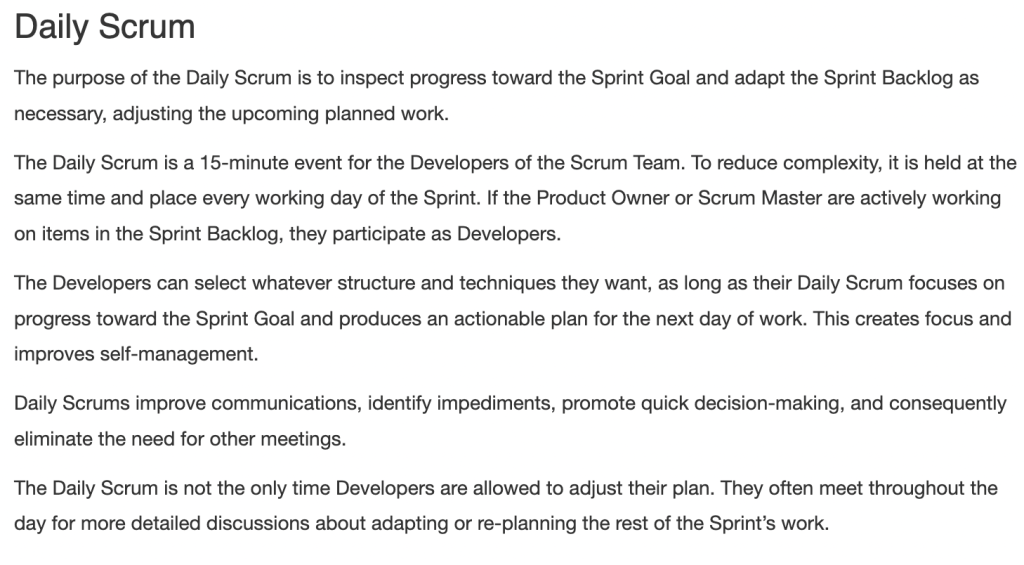Which two of the following answers are not correct about the Product Owner role?
A. The Product Owner measures the progress of a release.
B. The Product Owner decides which developer does what
C. The Product Owner is responsible for maximizing the value.
D. The Product Owner has to participate in the Daily scrum.
Quick Summary
Which two of the following answers ARE NOT CORRECT about the Product Owner role?
A. The Product Owner measures the progress of a release.
B. The Product Owner DECIDES which developer does what ✅. (NOT CORRECT)
C. The Product Owner is responsible for maximizing the value.
D. The Product Owner HAS TO participate in the Daily scrum. ✅ (NOT CORRECT)
Correct Answer: B,D
Explanation: The Scrum team is “self-organized” – that means that they decide on their own who does which task. Only the Development Team members have to participate in the Daily Scrum. Others like the Product Owner can attend (they shouldn’t talk)
The Product Owner’s Role in Scum
The Product Owner is responsible for measuring the progress of a release and maximizing the value of the product. Contrary to a statement, the Product Owner does not decide which developer does what; it is a collaborative effort with the development team. Additionally, while the Product Owner is involved in the Scrum process, their participation in the Daily Scrum is not mandatory, as it primarily serves the development team in planning their daily activities.
Developers are the people in the Scrum Team that are committed to creating any aspect of a usable Increment each Sprint.
From the Scum Guide
Let’s discuss the 4 different “supposedly” responsibilities of the Product Owner in scrum:
A. The Product Owner measures the progress of a release. The Product Owner does measure the progress of a release, ensuring that the team is delivering value in line with the product vision and goals.
B. The Product Owner decides which developer does what. The Product Owner collaborates with the development team but does not decide specifically which developer does what. The development team collectively determines how to turn product backlog items into increments of value. ❌ (NOT TRUE)
C. The Product Owner is responsible for maximizing the value. The Product Owner is indeed responsible for maximizing the value of the product and the work of the development team.
D. The Product Owner has to participate in the Daily scrum. While the Product Owner is involved in the Scrum process, they are not required to participate in the Daily Scrum. The Daily Scrum is primarily for the development team to synchronize activities and plan for the next 24 hours. The Product Owner can attend if they find it valuable, but it’s not mandatory. ❌ (NOT TRUE)
In summary, the Development Team is a crucial component of the Scrum framework, responsible for turning the Product Backlog into valuable and potentially shippable increments of the product. Their autonomy and self-organization are key principles in Scrum

In Scrum who decides which developer does what?

In Scrum, the responsibility for deciding what work each developer will do is typically a collaborative effort within the Development Team. Scrum emphasizes self-organizing teams and encourages a high degree of collaboration, flexibility, and shared accountability. Here are key aspects related to task assignment in Scrum:
- Self-Organizing Teams: Scrum promotes self-organizing teams, meaning that team members collectively decide how to best accomplish the work they commit to in a Sprint. The team is encouraged to organize and manage itself to deliver value.
- Development Team Collaboration: The Development Team collaborates to understand the Sprint Goal and the items from the Product Backlog selected for the Sprint during Sprint Planning. They work together to determine the best approach to delivering the committed work.
- Swarm or Pair Programming: Scrum Teams often encourage a collaborative approach where team members might pair up or “swarm” on particular tasks. This fosters knowledge sharing and helps ensure that the team collectively owns the work.
- Daily Standup Meetings: During the Daily Scrum (standup), team members share updates on their progress, discuss any impediments, and often reorganize work based on the current situation. If a team member needs assistance or if there’s a better way to approach a task, it is discussed and adjusted within the team.

- Skill Sets and Expertise: Team members often have different skill sets and expertise. The team collectively decides how to best leverage these skills to meet Sprint commitments. It’s common for team members to pick up tasks based on their expertise, but the team can adjust based on the needs of the Sprint.
- Rotating Tasks: Some teams implement a practice of rotating tasks among team members to avoid silos of knowledge and to ensure that everyone is cross-functional.
- Product Owner and Scrum Master: While the Development Team is responsible for selecting and delivering work, the Product Owner and Scrum Master can provide guidance, facilitate discussions, and help remove impediments. The Product Owner clarifies requirements and priorities, while the Scrum Master focuses on improving the team’s processes. Remember that the emphasis in Scrum is on the team’s collective ownership of the work. The goal is to maximize the effectiveness and creativity of the Development Team while delivering value to the customer. The way task assignments are handled can vary between teams, and teams often experiment and adjust their approach to find what works best for them.
Who has to participate in the Daily Scrum?

The Daily Scrum, also known as the Daily Standup, is a short, time-boxed event in Scrum that occurs every working day during a Sprint. The purpose of the Daily Scrum is for the Development Team to synchronize activities, discuss progress, and identify any obstacles. The key participants in the Daily Scrum include:
- Development Team: All members of the Development Team are required to attend the Daily Scrum. Each team member provides an update on their progress since the last Daily Scrum, shares their plans for the day, and communicates any impediments.
- Scrum Master: The Scrum Guide does not explicitly require the Scrum Master to be present at the Daily Scrum. The Scrum Guide provides flexibility for the Scrum Master’s involvement in the Daily Scrum and other Scrum events. While the Scrum Master is encouraged to attend the Daily Scrum to support and facilitate the team, their presence is not mandatory. The Scrum Master’s role is one of service to the Scrum Team, and they may choose the level of involvement that best serves the needs of the team.
- Product Owner: The Product Owner is invited to attend the Daily Scrum but is not required. If the Product Owner chooses to participate, it is usually in a passive role, listening to the team’s updates. The Product Owner may use the information to gain insights into the team’s progress.
You might like more…
- Which Scrum Role is Responsible to do all the Work Required to Turn Product Backlog in Potentially Releasable Items?
- Understanding the Role of Product Manager vs. Product Owner
- Product Management Terms
REFERENCES
Scrum Guide, 2021
